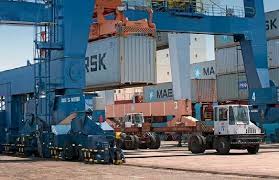Unlocking Kenya’s Maritime Potential: Critique of Hassan Ali Joho’s Vision

Inaugurates of Shipyard and New Ferry for Lake Victoria. (Pho/Courtesy)
By Andrew Mwangura
Email, thecoastnewspaper@gmail.com
Hassan Ali Joho’s presentation before the National Assembly’s Diaspora Affairs and Migrant Workers Committee, as a CS nominee, offered a promising vision for Kenya’s maritime sector.
His focus on leveraging the sector to drive economic growth and enhance diaspora welfare is timely, given Kenya’s strategic coastal position and the significant remittances from its diaspora, which reached Ksh643.5 billion in 2024.
However, while Joho’s enthusiasm and broad ideas signal ambition, his proposals lack the precision and actionable detail needed to inspire confidence in their execution.
This critique evaluates his remarks on the Ship Registry System, maritime training initiatives, and seafarer recognition, offering advisory insights to strengthen his vision while highlighting critical gaps that require attention.
Joho’s emphasis on the Ship Registry System as a catalyst for economic growth is a strategic acknowledgment of Kenya’s untapped maritime potential. By streamlining ship registration to attract both local and international shipping companies, he envisions Kenya as a competitive maritime hub.
This could boost foreign exchange earnings and create jobs, potentially increasing diaspora remittances.
However, the proposal’s strength is undermined by its lack of specificity. Joho failed to provide a clear timeline or outline the regulatory frameworks needed to make the system globally competitive.
For instance, aligning the registry with International Maritime Organization standards is essential to attract reputable shipping companies. Without this, Kenya risks being perceived as a flag of convenience, deterring serious investors.
Additionally, bureaucratic inefficiencies and corruption risks, which have historically plagued Kenya’s public sector, could erode investor confidence.
To address this, Joho should propose a transparent, technology-driven platform for ship registration, incorporating blockchain or similar tools to ensure efficiency and accountability. Engaging international maritime bodies and private sector stakeholders early in the process would also lend credibility and ensure compliance with global best practices.
A clear roadmap, with milestones and funding mechanisms, is critical to translating this vision into reality.
Joho’s focus on maritime training initiatives is another commendable step, particularly in addressing the committee’s concerns about the exploitation of Kenyan seafarers due to inadequate qualifications.
By prioritizing specialized training, he aims to equip Kenyans with skills to compete in the global maritime industry, reducing vulnerabilities exploited by rogue recruitment agencies.

This aligns with national goals to enhance employability and protect migrant workers. However, the proposal lacks detail on how these programs will be implemented or funded.
Partnerships with accredited maritime training institutions, both local and international, are essential to ensure quality and relevance. Moreover, Joho should address accessibility, particularly for low-income Kenyans who may struggle to afford such training. Subsidies or scholarships could bridge this gap.
Another critical oversight is the absence of a plan to integrate these initiatives with existing educational frameworks or to promote inclusivity.
The maritime sector has historically been male-dominated, and Joho missed an opportunity to advocate for targeted programs for women and youth. Such inclusivity would not only broaden the talent pool but also align with Kenya’s development goals of equity and empowerment.
A data-driven approach, with clear metrics on enrollment and job placement, would strengthen this initiative’s impact.
Joho’s call for better recognition and support for seafarers resonates strongly with the committee’s mandate to protect Kenyan migrant workers.
His acknowledgment of the need for improved consular services and repatriation support addresses real gaps, as evidenced by the committee’s scrutiny of embassy inefficiencies.
Kenyan seafarers often face exploitation abroad, including unfair wages and poor working conditions, and Joho’s advocacy for their welfare is a step in the right direction. However, his remarks lack concrete proposals to operationalize this support. For instance, establishing dedicated diaspora desks in key maritime hubs like Singapore or Dubai could provide real-time assistance to seafarers.
Similarly, leveraging digital platforms for consular services—such as mobile apps for emergency support—could enhance accessibility.
A significant gap in Joho’s presentation is the failure to mention bilateral labor agreements with countries hosting Kenyan seafarers. Such agreements are critical to ensuring fair wages, safe working conditions, and legal protections, complementing the committee’s push for a one-stop labor migration service center. Without these, Joho’s vision for seafarer welfare risks remaining aspirational rather than actionable.
To strengthen his proposals, Joho must prioritize stakeholder engagement. Collaborating with diaspora associations, maritime industry players, and international partners would ensure that his initiatives are practical and sustainable.
Regular progress reports to the committee could maintain accountability and build trust among stakeholders.
While Joho’s enthusiasm is evident, he must avoid overpromising without addressing systemic challenges like funding constraints and inter-agency coordination.
For instance, the Ship Registry System and training programs will require significant investment, yet Joho did not clarify potential funding sources, such as public-private partnerships or international grants.
Similarly, coordination between ministries—such as Transport, Education, and Foreign Affairs—will be critical to avoid siloed efforts.
A data-driven approach, with clear metrics for success, such as the number of ships registered or seafarers trained annually, would lend credibility to his vision.
In conclusion, Joho’s presentation lays a solid foundation for advancing Kenya’s blue economy and supporting its diaspora.
His focus on the Ship Registry System, maritime training, and seafarer welfare addresses critical economic and social priorities. However, the lack of specific implementation plans, funding strategies, and protections for migrant workers risks undermining his vision.

By refining his proposals with clear timelines, stakeholder collaboration, and targeted policies—like bilateral labor agreements and inclusive training programs—Joho can transform Kenya’s maritime sector into a robust engine for economic growth and diaspora empowerment.
His enthusiasm is a starting point, but only meticulous planning and execution will ensure that Kenya’s maritime potential is fully realized.
Andrew Mwangura is a policy analyst specializing in maritime governance and blue economy development.






